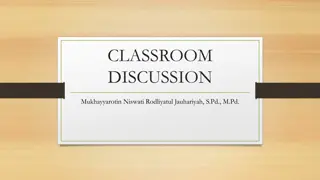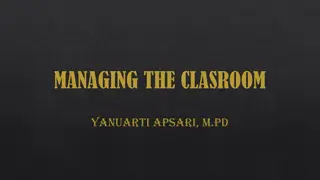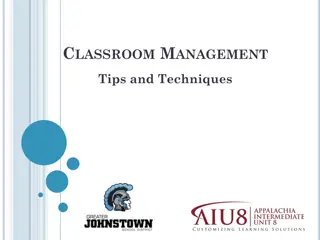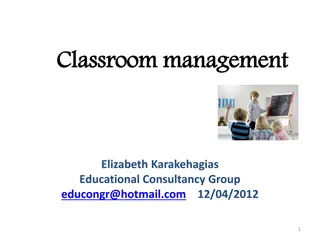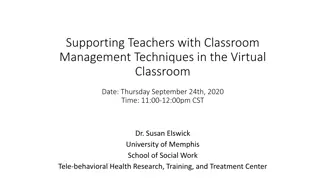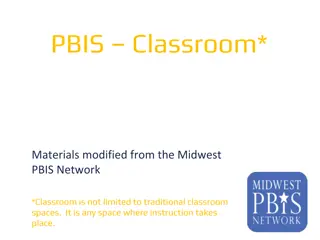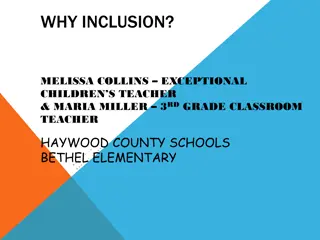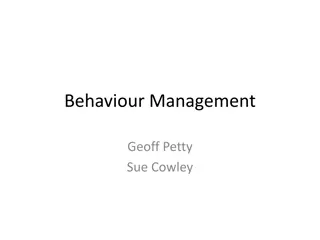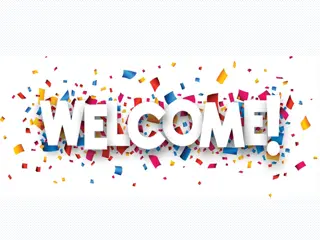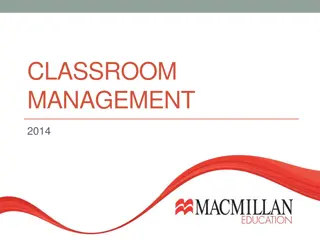Understanding Classroom Communication and Management by Ramkrishna Chakraborty
Communication is a vital process of exchanging information, ideas, and opinions between individuals. In the educational context, effective communication is essential for achieving desired behavior patterns. This article explores the meaning, concept, and types of communication, emphasizing the importance of verbal and non-verbal communication in classroom settings. Recognizing communication as a dynamic and social interaction process, it highlights the significance of clear and engaging communication strategies for successful classroom management.
Download Presentation

Please find below an Image/Link to download the presentation.
The content on the website is provided AS IS for your information and personal use only. It may not be sold, licensed, or shared on other websites without obtaining consent from the author. Download presentation by click this link. If you encounter any issues during the download, it is possible that the publisher has removed the file from their server.
E N D
Presentation Transcript
Classroom Communication & Management By Ramkrishna Chakraborty Asstt. Prof. & HOD Dept. of Education, Bengtol College
Meaning and Concept of Communication: Communication is a process of exchange. It is a process of sending and receiving facts, ideas, opinions, thoughts and information through speech, writing, gestures or symbols between two or more persons. Communication is the art of communicating. It is very essentials for both the individual and the group to acquired desired behaviour pattern.
The word communication is derived from the Latin word Communis, which means common . It signifies a process of common understanding in terms of knowledge, information, opinion, and thought shared by two or more individuals. According to some eminent educationists the word communication comes from the another Latin word communicare which means to share .
Definition of Communication: According to ARISTOTLE, Communication is a means of persuasion to influence the other so that the desired effect is achieved According to John Dewey Communication is a process of sharing experience till it becomes a common possessions. According to Hartman Communication is the control of behaviour through descriptive and reinforcing stimuli.
Characteristics of Communication: Communication is a two way process in which the sender transmits the message to receiver through some medium. Communication is form of social interaction. Communication is dynamic process. Communication can be Verbal, non-verbal or symbolic. Communication is the process in which information and ideas are exchanged and shared.
Types of Communication: From the language point of view communication can be classified in to two types:- Verbal Communication: Communication with the help of words is known as verbal communication. It is made through words either spoken or written. For example- meetings, lecture, group discussion etc. 1. 2. Non-Verbal Communication: Communication without any use of words is known as non-verbal communication. It may be visual, aural or gestural.
3. Aural communication:- Communication with the help of sound is called Aural communication. Bells, whistles, horns, siren are used to communicate our message. 4. Gestural Communication:- Communication through the use of various parts of our body or body language is known as Gestural communication.
Again Communication can be classified in to four categories: Intra-Personal Communication: Intra-Personal Communication may be defined as process through which the individual communicates with himself. For example thinking, working out a problem, writing diaries etc. Inter-Personal Communication: It may be defined as a process in which communication takes place between two individuals. For example classroom interaction between a teacher and a student. Group Communication: Group Communication may be defined as a process in which communication takes place between or more group. For example family meetings, committee meetings etc. Mass-Communication: Mass-Communication refers to a communication to a communication amongst large number of people of mass people. For example radio programmes, TV programmes etc. 1. 2. 3. 4.
Components of Communication : Sender: Sender is the person who sends the message. It is also termed as Source or Encoder who transmits the message from him or her to the receiver. For example the teacher in the classroom is the source or sender in the communication. 2. Receiver: The receiver is the person who receive the message. He is also known as decoder. For example the students in the classroom situation. 3. Message: It is the subject matter of communication, which contains facts, ideas, feelings, or thoughts. It must be precise and clear, well organized in a proper sequence. For example the subject matter that is taught in the classroom situation. 1.
4. Channel: Channel is the medium through which the message are transmitted from the sender to the receiver. Generally there are three types of channel written, verbal and non-verbal. 5. Setting: Setting refers to the actual environment in which different components of communications operate and interact. 6. Feedback : Feedback refers to the receiver s reaction or reply to the message, which is directed towards the sender . For example question answering of the teacher and the students in the classroom.
Barriers in Communication 7. Lack of physical facilities in the classroom 8. Socio-economic and cultural different among the students 9. Unsystematic presentation 10. Lack of feedback 1. Speedy narration 2. Inaudibility of speech 3. Difficult vocabulary 4. Unfamiliar pronunciation of the teacher 5. Poor handwriting 6. Explanation without illustration
Suggestion for better classroom communication The teacher should create trust through consistent performance in the minds of the students. The message must be explained with possible data and diagrams besides illustrations. The teacher should explain the technical terms in simple, well understood direct language. The teacher should give special emphasize on the emotional condition of the students. Teacher should use various modern communication devices. The teacher should be encouraged to employ written communication tools.
Meaning of Educational Management Educational Management is directly linked with the arrangement process of an educational institution. In an educational institution, the process of management or the situational arrangement is designed or planed for fostering the effectiveness of the teaching learning process. According to Henry Fayol Educational management is to manage is to forecast and plan, to organize, to command, to coordinate and to control . According to F.W. Taylor Management is the art of knowing what you want to do in the best and cheapest way .
Classroom Management Classroom management is on of the important duty and responsibility of a teacher. Success in teaching depends to a great extent on classroom management. For effective teaching classroom management is a must. By the term Classroom Management we mean the management of all the resources available in a classroom such as human resources in the form of teachers, material resources in the form of black board, furniture, teaching aids and equipment and the time management.
The Prime objectives of classroom management:- Developing good interpersonal relationship between the teacher and the student. 2. Maintaining discipline in the classroom. 3. Encouraging self-learning habit. 4. Providing knowledge in a better way. 5. Facilitating all round development of the student. 1.
Teacher and classroom Management: the class. As a management expert of the class, a teacher has to enforce his leadership and authority. As the teacher has to deal with some young people, who are naturally very much emotional in temperament, his authority does not mean autocratic domineering behaviour and over use of power. Teachers authority along with love is the heart of successful classroom management. A Teacher has to bear the burden of managing
Strategies for classroom management The teacher has to adopt different strategies for better management of the classroom environment. These are : 1. Planning the work schedule 2. Behaviour of the teacher 3. Development of virtues of classroom conduct 4. Teachers role on discipline of the classroom 5. Evolving inter-personal relation 6. Classroom monitors or captain selection
Suggestions for better classroom management To produce a high rate of work involvement. 2. The teacher should be very actively plan his teaching strategies and techniques. 3. Using different teaching techniques in the classroom. 4. The sitting arrangement should be laid out in a proper manner. 5. Time management skill place and important part in better classroom management. 6. The material resources should be arranged properly. 1.
The destiny of India is now being shaped in her classroom. ---- Kothari Commission(1964-66) THANK YOU




